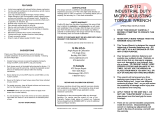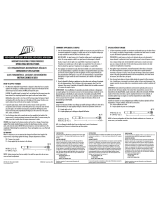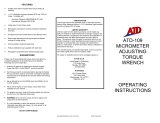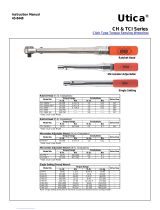
Micrometer
Adjustable
Torque Wrenches
Part Nos. 7375
7377
7378
7379
Operating Instructions
Certification
This torque wrench was calibrated prior to shipment
from the factory with tolerance limits of ±3% clockwise
(right-handed) accuracy of upper 80% of range.
NOTE: Part No. 7379 has tolerance limits of ±4%
clockwise (right-handed) accuracy, and ±6%
counterclockwise (left-handed) accuracy.
Limited Warranty
Until one year from the date of purchase, we will repair
any defect in material or workmanship free of charge.
Improper use of these products, including but not
limited to the application of excessive force, will affect
performance and may result in injury. The warranty
does not apply to wrenches which do not function
properly or within specified accuracy because of wear,
improper or unreasonable use, damage not resulting
from defect or malfunction, or which have been altered.
Calibration is warranted for 90 days.
This warranty gives you specific legal rights, and you
may also have other rights which vary from state to
state.
For repair or calibration, send wrench, postage prepaid,
to: Angle Repair Service, Inc.
175 Angle Drive
Beckley, West Virginia 25801
SPX Corporation
655 Eisenhower Drive
Owatonna, MN 55060-0995 USA
Phone: (507) 455-7000
Tech. Serv.: (800) 533-6127
Fax: (800) 955-8329
Order Entry: (800) 533-6127
Fax: (800) 283-8665
International Sales: (507) 455-7223
Fax: (507) 455-7063
Form No. 106510
© SPX Corporation 10-12-2000
Features
•
Operates and ratchets in both right- and left-hand
directions.
•
May be used for uncontrolled wrenching as long as
torque does not exceed maximum capacity.
•
Lock ring prevents accidental change of torque
setting.
•
All parts corrosion-proofed. Wrench made of highest
quality heat-treated steel, and finished with tough,
durable chromium-nickel plating.
•
Hand grip is impervious to fluids such as gasoline,
oil, and kerosene.
CAUTION: To prevent personal
injury when using these torque
wrenches, wear eye protection that
meets ANSI Z87.1 and OSHA
standards.
Grip
Lock Ring
Thimble Scale
Main Scale
ll
ll
l
ll
ll
l
ll
ll
l
ll
ll
l

Adjusting the Torque Wrench
IMPORTANT: To prevent damage to the adjusting
mechanism, do NOT turn the GRIP with the LOCK
RING in the lock position.
Examples of Torque Settings
The main scale American Standard graduations are on
the front of the shaft, and the thimble scale graduations
are closest to the beveled edge.
The main scale Metric graduations are on the reverse
side of the shaft, and the thimble scale Metric
graduations are below the American Standard
graduations.
American Standard
1. For a torque setting of 94 foot pounds, rotate the grip
until the “0” on the thimble scale is aligned with the
“85” on the “ft. lb.” main scale.
2.Continue rotating the grip
clockwise until the “9” on the
thimble scale is aligned with
the center line on the “ft. lb.”
main scale. The wrench is now
set at 94 ft. lbs. (85 + 9 = 94).
How to Apply Torque
The Micrometer Torque Wrenches are designed to
give an audible signal and/or impulse when force has
been correctly applied to the hand grip, and the desired
torque attained. Do NOT pull beyond this point.
IMPORTANT:
•
The audible signal / impulse is an indicator that the
correct torque has been reached. Over torquing
beyond this point could cause fastener failure.
•
Do NOT tilt the torque wrench handle during a
torquing operation. Tilting the handle can result in
inaccurate torque and/or over-torquing damage.
NOTE: When the wrench is set at the low end of the
torque range, the degree of signal / impulse will be less
than when the wrench is set at the high end of the
range. Therefore, take special notice at the low end of
the scale to hear the signal or feel the impulse.
1.Securely attach a socket to the torque wrench square
drive.
2.Position the socket squarely on a fastener.
3.Grasp the center of the hand grip, and apply a force
perpendicular (90 degrees) to the torque wrench
body, and perpendicular (90 degrees) to the center
line of the square drive, socket, and fastener.
1.To unlock the torque wrench,
hold the handle grip with one
hand, and turn the lock ring
clockwise until it stops.
3.Put the lock ring in the lock position before using the
wrench.
Metric
1.For a torque setting of 105.8 Newton meters, rotate
the grip until the “0” on the thimble scale is aligned
with the “104.4” on the “N•m” main scale.
2.Continue rotating the grip
clockwise until the “1.4” on the
Metric thimble scale is aligned
with the center line on the “N
•
m”
main scale. The wrench is now
set at 105.8 N
•
m (104.4 + 1.4 =
105.8).
3.Put the lock ring in the lock position before using the
wrench.
IMPORTANT: To prevent damage to the torque wrench,
NEVER apply more torque than the rated capacity of
the wrench.
2.Rotate the grip until the “0” on
the thimble scale reaches the
primary number of the desired
torque value on the shaft main
scale.
3.Continue rotating the grip if the
desired torque value is between
the primary numbers on the
main scale. Add the secondary
number on the thimble scale to
the primary number on the main
scale to achieve the desired
torque value. Refer to
Examples
of Torque Settings
section.
4.To lock the wrench, hold the handle grip with one
hand, and turn the lock ring counterclockwise until it
stops.
NOTE:
•
Grasp the GRIP, not the SHAFT.
•
Clean thread surfaces and remove burrs from
fasteners.
•
It is not necessary to return this wrench to its lowest
calibrated value after use, unless it will be stored for
an extended period of time.
NOTE: Maintain the common center line of the square
drive, socket, and fastener while applying a steadily
increasing force – this ensures an accurate torque
reading.
4.Turn the fastener down using a smooth and even
force applied to the handle of the torque wrench. As
turning resistance increases, pull more slowly. To
ensure accuracy, the fastener must be in motion
when the torques measurement is made.
90°
-
 1
1
-
 2
2
Ask a question and I''ll find the answer in the document
Finding information in a document is now easier with AI
Related papers
Other documents
-
 ATD Tools ATD-112 User manual
ATD Tools ATD-112 User manual
-
Husky H3DTWA H2DTWA Operating instructions
-
 ATD Tools ATD-12500 Operating instructions
ATD Tools ATD-12500 Operating instructions
-
URREA 6015FL Owner's manual
-
 ATD Tools ATD-109 User manual
ATD Tools ATD-109 User manual
-
 gio Vyper 4WD 1100cc XY1100UE User manual
gio Vyper 4WD 1100cc XY1100UE User manual
-
Bahco 7455-1500 User manual
-
GearWrench 85060 Specification
-
 UTICA BOILERS CHA-11 User manual
UTICA BOILERS CHA-11 User manual
-
Yamaha DRAG STAR XVS1100A Owner's manual






